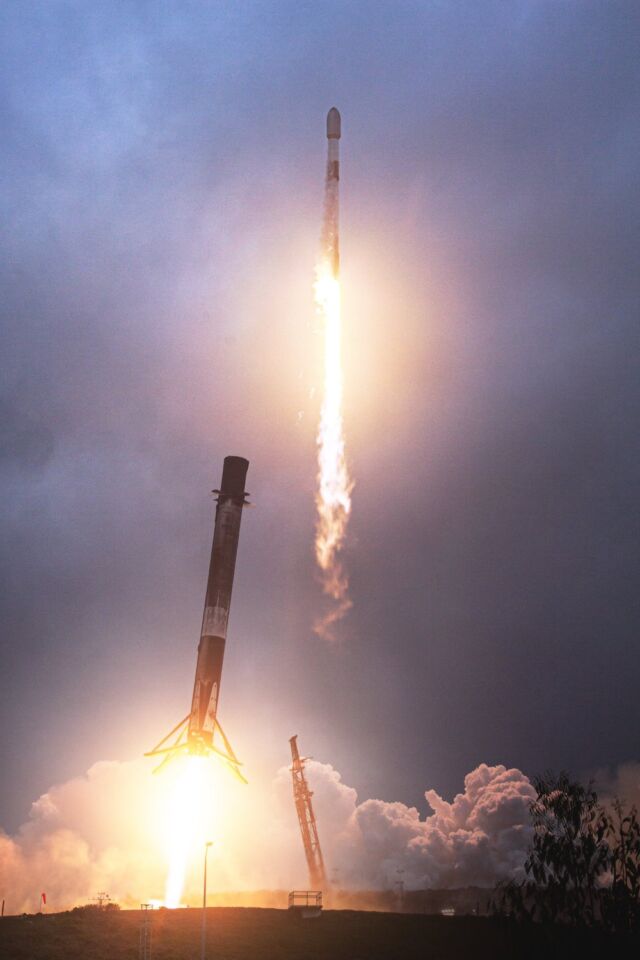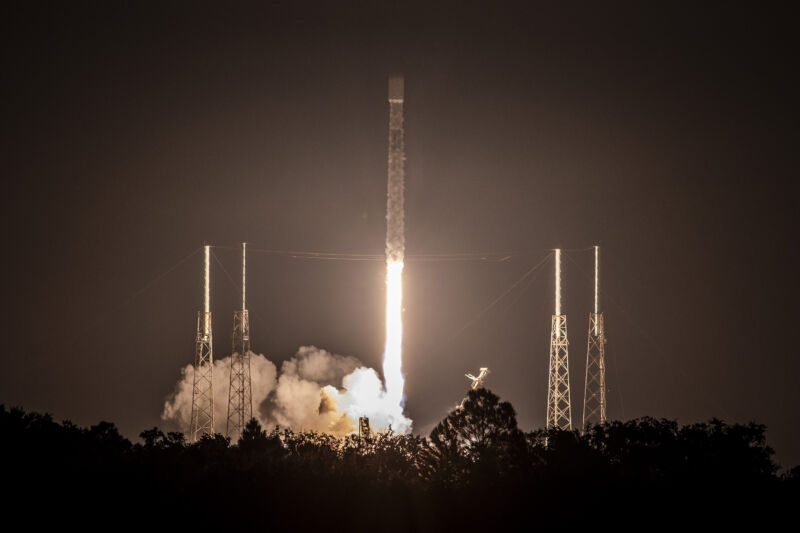SpaceX aims to ramp up to a dozen launches per month next year.
It probably seems like SpaceX is launching almost every day, and that's not far from the case. It also might seem like SpaceX is regularly breaking one of its records, whether it's in the number of launches, turnaround time, or reusing Falcon 9 boosters. It's also true.
SpaceX blew past one of those records over Labor Day weekend when the company launched a Falcon 9 rocket from NASA's Kennedy Space Center in Florida. This mission was SpaceX's 62nd launch of the year using its Falcon 9 or Falcon Heavy rocket, or 63rd if you count the test flight of the Starship mega-rocket in April.
SpaceX has launched 83 Falcon 9 or Falcon Heavy missions over the past 12 months.
Elon Musk, SpaceX's founder and CEO, says the launch cadence will only ramp up over the coming months.
"Aiming for 10 Falcon flights in a month by end of this year, then 12 per month next year," Musk posted on X, his social media platform. SpaceX has already strung together 10 Falcon launches within a 30-day period. That will soon become the norm if SpaceX achieves its goal.
SpaceX is leading the world not just in the number of launches, but also in the total payload mass the company has launched into orbit this year. In the first half of 2023, SpaceX delivered about 447 metric tons of cargo into orbit, roughly 80 percent of all the material launched into orbit worldwide, according to data from the space analytics firm BryceTech.
Musk said SpaceX will launch about 90 percent of the world's total payload mass into orbit next year, based on the company's launch manifest for 2024.
Blink, and you'll miss it
Nearly 60 percent of SpaceX's missions so far this year have carried Starlink Internet satellites into orbit. SpaceX has launched three astronaut missions to the International Space Station, along with three Falcon Heavy rockets since the start of the year.
It almost goes without saying that a key factor in SpaceX's increasing launch cadence is the company's reuse of first-stage boosters and payload fairings. In July, SpaceX launched a Falcon 9 booster for its 16th flight as engineers extended the first stage's usable life from 15 flights to 20 missions. This life extension will, for now, only be used for Starlink launches, according to SpaceX.
SpaceX's launch teams are also reconfiguring launch pads at a faster rate. The turnaround time at SpaceX's most-used launch pad in Florida was reduced to less than four days between missions this year. This is important as SpaceX's other launch facility in Florida has been tied up with Falcon Heavy missions and astronaut launches, which typically take longer to prepare for each flight.
In California, SpaceX's West Coast launch pad has hosted 18 Falcon 9 missions. The Falcon 9 launch pad in California has an older design that takes longer to set up for each mission, mainly because of the design of its strongback, the truss-like structure stands next to the rocket during the final countdown. The strongback in California does not swing away from the rocket at liftoff, while the ones in Florida do.
That exposes the strongback to a blast of fiery exhaust as the Falcon 9 climbed off the pad, increasing the refurbishment required between launches. Despite this issue, SpaceX's ground crew in California has been able to launch Falcon 9 missions as few as 10 days apart.

This composite photo shows the launch of a Falcon 9
rocket from California on September 2 with a batch of
US military satellites, followed by landing of the booster
a few minutes later.
SpaceX's other 44 launches so far this year have departed from Florida. The spaceport there has now supported 46 orbital launch attempts this year, including SpaceX, United Launch Alliance, and Relativity Space. That puts the Florida launch base on pace to surpass the 57 launches it hosted last year.
Officials from the US Space Force's Eastern Range, which oversees launch activity from Cape Canaveral Space Force Station and the Kennedy Space Center, have streamlined their operations to accommodate the higher launch demand, driven primarily by SpaceX. SpaceX's rockets use autonomous flight termination systems, which would self-activate to destroy the rocket in the event of an in-flight failure. This means the Space Force's range requires less infrastructure and a smaller workforce for a launch that uses a human-in-the-loop destruct system.
The Space Force is also no longer closing the range at Cape Canaveral for maintenance. In some past years, the military would set aside a couple of weeks per year for upgrades and refurbishment of ground systems, grinding launches to a halt.
“When the Eastern Range was supporting 15 to 20 launches a year, we had room to schedule dedicated periods for maintenance of critical infrastructure," said Brig. Gen. Kristin Panzenhagen, commander of Space Launch Delta 45 and director of the Eastern Range. "During these periods, launches were paused while teams worked the upgrades. Now that the launch cadence has grown to nearly twice per week, we’ve adapted to the new way of business to best support our mission partners.”
The rest of 2023
SpaceX will stay busy with numerous launches over the next few months. The most high-profile one is the second test flight of the giant Starship rocket from South Texas, a launch that might happen as soon as this month.
There are two more Falcon Heavy rockets scheduled to take off this year, beginning with the launch of NASA's Psyche asteroid probe on October 5 from Florida. Another Falcon Heavy is slated to launch a US Space Force mission later in the year.
In November, SpaceX plans to launch a Falcon 9 rocket with a commercial lunar lander developed by Intuitive Machines, a Houston-based company that aims to land the first privately owned spacecraft on the Moon.
There are also two resupply missions to the International Space Station on tap for launch on Falcon 9 rockets later this year. One of those will use SpaceX's Dragon cargo capsule, and the other will haul a Northrop Grumman Cygnus supply ship into orbit. This will be the first of at least three Northrop Grumman resupply missions to launch on SpaceX rockets following the retirement of that company's Antares launcher.
And the Missile Defense Agency plans to launch the Hypersonic and Ballistic Tracking Space Sensor mission into orbit later this year on a Falcon 9 rocket. This new sensor will have improved sensitivity to detect and track hypersonic missiles, which have lower heat signatures from their exhaust plumes than larger long-range ballistic missiles, making them more challenging to see with the military's existing missile-tracking satellites.
Source



3175x175(CURRENT).thumb.jpg.b05acc060982b36f5891ba728e6d953c.jpg)

Recommended Comments
There are no comments to display.
Join the conversation
You can post now and register later. If you have an account, sign in now to post with your account.
Note: Your post will require moderator approval before it will be visible.